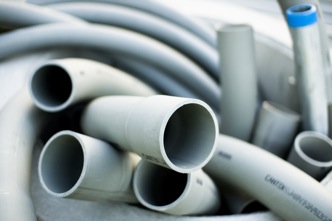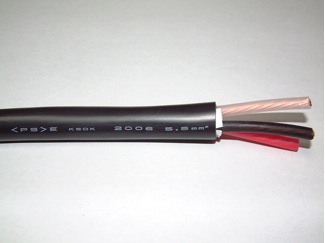What is Insulated Wire?
Insulated wire or cable consists of a non-conductive material resistant to an electric current. It surrounds and protects the wire or cable inside.
What Are The Benefits of Insulated Wire?
The obvious benefit of insulated wire is the color. While this may seem simple, it’s very important, especially in sophisticated wire and cable applications. Colored insulation can help you determine the difference between wires when there are many running together. Designated wires for different applications can help the wired network remain organized.
Wires that are insulated are also corrosion and crush resistant. Ensuring your wire will last is essential to the longevity of your installation.
What Causes Wire to Corrode?
Chemical exposure, environmental pressure, weather, and flexibility issues can cause the wire to corrode.
Chemicals – For many household appliances and underground cable applications, there are harmful chemicals.
Luckily, Performance Wire & Cable offers HALAR cathodic protection cable. This insulated wire is highly resistant to chlorine, hydrogen gases, and other chemicals that lead to corrosion. HALAR wire is commonly used directly in water and damp environments because of its properties.
KYNAR insulated cables are also a good choice if you’re looking for chemical resistance.
Weather – There are insulated wires explicitly made to perform in high temperatures and those best suited for very fridged temperatures. Cross-linked polyethylene, also known as XLPE cables, are perfect for these types of applications. Additionally, insulated wire offers protection against wetness.
Flexibility – If a cable is going to be bent frequently, it must have proper insulation to give it freedom of motion. If not, the wire will not last.
Pressure – It’s no secret that wires are also commonly used underground. There can be an incredible amount of pressure on the wire from the weight of the earth above it. To maintain maximum performance, wires cannot succumb to being crushed.
HMWPE cathodic protection cables provide outstanding resistance to crushing and pressure. The wire insulation is a high molecular weight polyethylene material protecting your copper cables.
Why Choose Insulated Wire?
Not only is insulated wire corrosion-resistant, but it is also cost-effective. It’s better to buy insulated wire than wire that needs to be repaired or replaced. Replacement or repair of wire will lead to service disruption and cost, which is not ideal.
Safety is essential in wiring applications. Wires carry current that can cause electric shock when touched or cause electrical explosions, shorted wire systems, and more. Insulated wire is the safest choice.
Insulated Wire, What’s Protecting Your Cable?
There are varieties of available insulations for wire and cable. Insulated wire or cable is coated with a non-conductive material that is resistant to an electric current, which surrounds and protects the wire and cable inside.
Cable and wire insulation prevents the wire’s current from coming into contact with other conductors, it preserves the wire material against environmental threats and resists electrical leakage. There are three major categories of wire insulation, each with a variety of styles. These include plastic, fluoropolymers, and rubber.
Plastics
| Polyvinyl Chloride (PVC) | This is an inexpensive and easy-to-use material. This type of wire insulation can be used in diverse applications. The temperature range is -55°C to 105°C and it is flame, moisture, and abrasion-resistant. PVC insulated wire holds up against gasoline, ozone, acids, and solvents and is safe for medical and food-related purposes as it is odorless, tasteless, and non-toxic. |
| Semi-Rigid PVC (SR-PVC) | A form of PVC cable insulation, this is mainly used as primary insulation and is very abrasion-resistant. Semi-rigid PVC is resistant to heat, water, acid, and alkali, as well as being flame-retardant. |
| Plenum Polyvinyl Chloride (Plenum PVC) | Plenum PVC, yet another polyvinyl chloride wire insulation material, is great for use in building spaces behind dropped ceilings or raised floors, which are left open to allow for air circulation. |
| Polyethylene (PE) | This wire insulation compound is used most on coaxial and low capacitance cables. It carries exemplary electric qualities, although it is flammable. Many times, this cable insulation is used in certain applications because it is affordable and can reduce the dielectric constant, making it an attractive option for cables requiring high-speed transmission. Polyethylene can also be cross-linked to produce high resistance to cracking, cut-through, soldering, and solvents. PE can be used in temperatures ranging anywhere from -65°C to 80°C. All densities of Polyethylene are stiff, hard, and inflexible. Performance Wire and Cable offers HMWPE as popular insulation for products. |
| Polypropylene (PP) | Very similar to polyethylene, polypropylene has a wider temperature range of 30°C to 80°C. This wire insulation is used primarily within thin walls. |
| Polyurethane (PUR) | From extremely low to very high temperatures, polyurethane is known for its extreme toughness, flexibility, and flex life. Because of the excellent ratings for chemical, water, and abrasion resistance, this material works well in retractile cord applications and can be a good option for salt-spray and low-temperature military purposes. |
| Chlorinated Polyethylene (CPE) | Commonly found in power and control cables as well as industrial power plant applications, CPE cable insulation displays very good heat, oil, and weather resistance. More times than not, CPE serves as a lower cost and more environmentally friendly alternative to chlorosulfonated polyethylene. |
| Nylon | Nylon, very flexible wire insulation, is usually extruded over softer insulation compounds. It serves as a tough insulation, exhibiting strong abrasion, cut-through, and chemical resistance. |

Fluoropolymers
| PFA | Although more expensive than other insulations, PFA has temperature ratings ranging from 250°C to 65°C. PFA insulated wire is an electrically efficient option due to its low dissipation factor. |
| Polytetrafluoroethylene (PTFE) | PTFE is resistant to water, oil, chemicals, and heat that can be used in a wide range of temperatures, -73°C to 204°C. |
| Fluorinated Ethylene Propylene (FEP) | Commonly used in plenum cable and military applications, this material is widely used due to its processing characteristics and variety of applications. |
| ETFE Tefzel and ECTFE HALAR | Stronger and more flexible than PFA or FEP these resources can become thermoset through irradiation. Foaming ECTFE HALAR and ETFE improves data transmission and reduces weight. |
| Polyvinylidene Fluoride (PVDF) | PVDF is also commonly called KYNAR and is used in a wide range of industries due to its low cost. It is flexible, lightweight, and thermally stable, as well as chemical, heat, weather, abrasion, and fire resistant. |
| Thermoplastic Elastomers (TPE) | Thermoplastic elastomers consist of a mix of polymers, typically a plastic and a rubber. TPE, usually used in automotive and household appliances, can be molded, extruded, and reused, similar to a plastic, while maintaining the flexibility and stretch of rubber. |

Rubbers
| Thermoplastic Rubber (TPR) | In many applications, TPR is used to replace true thermoset rubber. It has improved colorability, higher processing speeds, and a wider usable temperature range. It also displays excellent heat, weather, and age resistance without curing. TPR is not cut-through resistant but can be used in applications where other properties of rubber are preferred. |
| Neoprene (Polychloroprene) | This wire insulation material is a synthetic thermoset rubber that exhibits supreme abrasion, cut-through, oil, and solvent resistance. Neoprene is also known for its usability, long service life and use with wide ranges of temperatures. It is remarkably flame retardant and self-extinguishing. |
| Styrene Butadiene Rubber (SBR) | Similar to Neoprene, it has a wide temperature range of -55°C to 90°C. SBR is primarily used to insulate Mil-C-55668 cables. |
| Silicone | Silicone is heat resistant, flame retardant, and can be used in temperatures up to 180°C. It is also extremely flexible and good in many electrical applications where wire/cable insulation is needed. |
| Fiberglass | Fiberglass can be used in extreme temperatures up to 482°C. This wire/cable insulation material is moisture and chemical resistant. Its common applications are heat-treating, glass and ceramic kilns, foundries, and extensive applications in aluminum processing. |
| Ethylene Propylene Rubber (EPR) | EPR is typically used in temperatures ranging from -50°C to 160°C. It is commonly used in high-voltage cables. EPR is also heat, oxidation, weather, water, acid, alcohol, and alkali resistant. |
| Rubber | Due to the variety of formulas that can be used to create rubber insulation, temperature ranges vary as well. Some good characteristics of rubber insulation include low-temperature flexibility, water and alcohol resistance, electrical properties, and excellent abrasion resistance. |
| Chlorosulfonated Polyethylene (CSPE) | CSPE, sometimes referred to as Hypalon, is resistant to chemicals and UV rays. It works well as a low-voltage insulation and performs at a wide range of temperatures. This insulation material can be found in appliance wire, lead wire, coil leads, transformer leads, and motor lead wire. |
| Ethylene Propylene Diene Monomer (EPDM) | Stands up to temperatures of 55°C to 150°C while still being flexible at these temperatures. Has an excellent electrical property as well as heat, ozone, weather, and abrasion resistance. |
For expert advice on selecting the right insulation for your wires and cables, contact our specialists at Performance Wire & Cable. We’re here to ensure your application meets all safety and performance standards.
